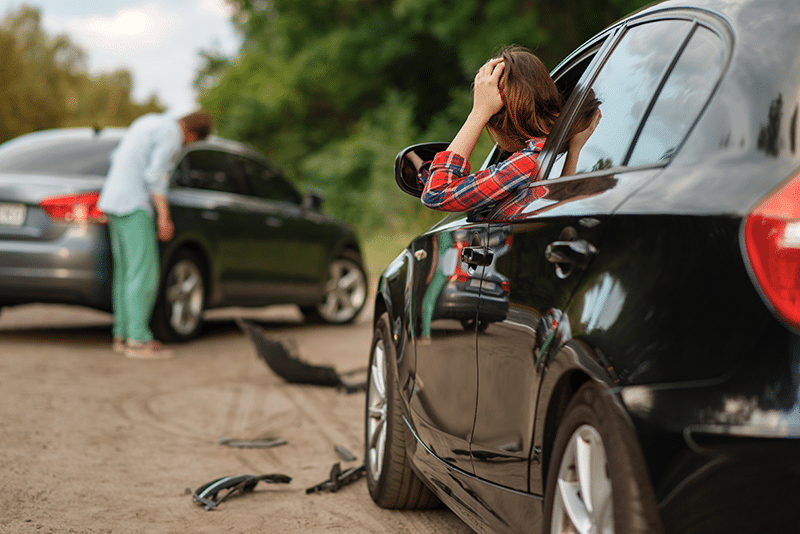Introduction
Blunt force trauma from a car wreck is a common and severe injury, and if you’ve been in a car wreck and have suffered blunt force trauma, you will need to see a doctor immediately. It can range from mild to life-threatening, and it occurs when a person is hit by a car or other object with great force. This type of trauma can cause a variety of serious injuries, including broken bones; internal bleeding; head injuries; spinal cord injuries; and organ damage.
Symptoms of Blunt Force Trauma
The symptoms of blunt force trauma can vary depending on the severity of the injury, but some common symptoms include: pain or tenderness at the site of the injury; swelling; bruising; numbness or tingling; difficulty moving the injured area; and dizziness or confusion. If you experience any of these symptoms, it is important to seek medical attention immediately.
Diagnosis and Treatment of Blunt Force Trauma
Doctors will typically diagnose blunt force trauma based on the patient’s symptoms and a physical examination. X-rays or other imaging tests may be used to confirm the diagnosis and to assess the extent of the injury. Depending on the severity of the injury, treatment may include rest, ice, compression, and elevation; pain relievers; physical therapy; surgery; or a combination of these treatments.
Prevention of Blunt Force Trauma
There are many things you can do to prevent being injured in a car wreck, and some of the most effective ways include: wearing a seatbelt every time you get in a car; driving defensively; and avoiding driving under the influence of alcohol or drugs. If you are involved in a car wreck, it is important to stay calm and to seek medical attention immediately if you experience any symptoms of blunt force trauma.
Conclusion
Blunt force trauma from a car wreck is a serious injury that can have long-term consequences. If you have been injured in a car wreck, it is important to seek medical attention immediately and to follow your doctor’s instructions for treatment. By taking these steps, you can help to improve your chances of a full recovery.
Blunt Force Trauma in Car Accidents: A Perilous Impact
Imagine yourself behind the wheel, navigating the urban jungle, when suddenly, an impact jolts you with unimaginable force. Your body, once a finely tuned machine, is now subject to the cruel whims of blunt force trauma, a silent assailant lurking within the turmoil of a car accident.
Causes: Unraveling the Devastating Effects
Blunt force trauma, a grim reality in car crashes, occurs when a body collides with an unyielding object at high velocity. This violent encounter can inflict a devastating array of injuries, from catastrophic fractures to life-threatening organ damage.
Mechanisms of Injury: A Symphony of Impact and Velocity
The severity of blunt force trauma hinges upon an intricate interplay of impact force and the body’s resilience. The magnitude of the collision, measured in terms of velocity and mass, governs the extent of damage inflicted. As the impact intensifies, the body’s delicate tissues are subjected to a brutal symphony of compression, shear, and acceleration forces. This catastrophic ballet of trauma can leave behind a trail of shattered bones, lacerated organs, and internal bleeding.
Head Injuries: The Silent Assassin
In the cruel calculus of car accidents, the head emerges as a prime target for blunt force trauma. The brain, encased within the protective shell of the skull, is particularly vulnerable to the impact’s unforgiving assault. Concussions, skull fractures, and even life-altering traumatic brain injuries can lurk beneath the surface, posing a hidden threat to consciousness and cognitive function.
Chest Injuries: A Breathtaking Trauma
The chest, a vital sanctuary for our life-giving organs, is another frequent victim of blunt force trauma. The impact of the accident can compress the chest, crushing the delicate tissues within and disrupting the vital exchange of oxygen and carbon dioxide. Rib fractures, collapsed lungs, and heart contusions are among the devastating consequences that can arise from this relentless assault.
Abdominal Injuries: A Guttural Assault
The abdomen, a teeming metropolis of vital organs, is also susceptible to the wrath of blunt force trauma. The liver, spleen, and intestines can be ruthlessly lacerated or ruptured, spewing their contents into the body’s once-sterile cavity. Internal bleeding, infection, and even life-threatening organ failure can follow in the wake of this guttural assault.
Conclusion: Echoing the Silent Peril
Blunt force trauma in car accidents is a harrowing reality, a testament to the destructive forces that can be unleashed in a split second. Its effects can range from the minor to the catastrophic, leaving behind a trail of shattered bodies and shattered lives. By understanding the mechanisms of injury and the devastating consequences that can arise, we can better appreciate the importance of safe driving and the life-saving potential of timely medical intervention. For in the deafening silence that follows the impact, knowledge and preparedness can be the flickering beacon of hope amidst the darkness.
Blunt Force Trauma: What You Need to Know
Blunt force trauma is a serious injury that can occur when a person is hit by a hard object, such as a car or a baseball bat. This type of injury can cause a variety of symptoms, depending on the severity of the trauma. In some cases, blunt force trauma can even be fatal.
Symptoms
The symptoms of blunt force trauma can vary depending on the severity of the injury. However, some of the most common symptoms include pain, swelling, bruising, and difficulty moving the affected area. In some cases, blunt force trauma can also cause internal bleeding, organ damage, or even death.
Causes
Blunt force trauma can be caused by a variety of factors, including car accidents, falls, and sports injuries. In some cases, blunt force trauma can also be caused by intentional violence, such as assault or battery.
Treatment
The treatment for blunt force trauma depends on the severity of the injury. In some cases, simple first aid measures, such as applying ice and compression, may be enough to treat the injury. However, in more severe cases, surgery or other medical treatment may be necessary.
Prevention
There is no sure way to prevent blunt force trauma. However, there are some things you can do to reduce your risk of being injured, such as wearing protective gear when playing sports or riding a bike, and avoiding situations where you could be hit by a hard object.
Recovery
The recovery time from blunt force trauma depends on the severity of the injury. In some cases, people may recover quickly, while in other cases, it may take months or even years to fully recover. During recovery, it is important to follow your doctor’s instructions and to get plenty of rest.
Blunt Force Trauma: A Devastating Impact
When a car accident occurs with immense force, the result can be devastating. Blunt force trauma, a leading cause of injuries in such collisions, strikes the victim with an object that doesn’t pierce the skin. Understanding the diagnosis, treatment, and aftermath of blunt force trauma can empower victims on their road to recovery.
Diagnosis: Assessing the Damage
Following a blunt force trauma car accident, seeking medical attention promptly is crucial. Doctors will conduct a thorough physical examination to assess any visible injuries, such as cuts or bruises. They’ll also ask about the victim’s medical history, including any pre-existing conditions that may be affected.
Symptoms: A Spectrum of Effects
The symptoms of blunt force trauma vary widely, depending on the severity of the impact. Some common symptoms include:
- Pain and swelling at the site of the injury
- Headaches, dizziness, or nausea
- Vision changes or hearing loss
- Difficulty breathing or shortness of breath
- Cognitive problems, such as memory loss or confusion
Treatment: Restoring Health
Treatment for blunt force trauma aims to alleviate pain, minimize further injury, and promote healing. It may involve:
- Rest and immobilization to allow injured tissues to recover
- Pain medication to manage discomfort
- Surgery to repair severe injuries
- Physical and occupational therapy to regain mobility and function
Prognosis: The Road Ahead
The prognosis for blunt force trauma depends on the extent of the injuries. Some victims make a full recovery, while others face long-term challenges. However, with proper treatment and support, most individuals can improve their quality of life after such a traumatic event.
Blunt Force Trauma: A Silent Danger in Car Accidents
Picture this: you’re driving down the road, minding your own business, when suddenly, out of nowhere, a car slams into yours. In the blink of an eye, your world is turned upside down. You’re disoriented, in pain, and wondering what just happened. If you’re lucky, you’ll walk away from the accident with just a few bumps and bruises. But for some, the injuries are much more severe, including blunt force trauma.
Blunt force trauma is a type of injury that occurs when a person is hit by a hard object, such as a car. This type of trauma can cause a wide range of injuries, from minor cuts and bruises to broken bones and internal bleeding. In some cases, blunt force trauma can even be fatal.
Symptoms of Blunt Force Trauma
The symptoms of blunt force trauma vary depending on the severity of the injury. However, some common symptoms include:
- Pain
- Swelling
- Bruising
- Headache
- Nausea
- Vomiting
- Confusion
- Loss of consciousness
Treatment
Treatment for blunt force trauma depends on the severity of the injury. However, some common treatments include:
- Rest
- Ice
- Compression
- Elevation
Recovery from Blunt Force Trauma
Recovery from blunt force trauma can take time. The length of time it takes to recover depends on the severity of the injury. However, most people can expect to make a full recovery within a few weeks or months. In some cases, however, recovery may take longer. For example, people who have suffered a traumatic brain injury may need to undergo long-term rehabilitation.
How to Prevent Blunt Force Trauma
The best way to prevent blunt force trauma is to avoid being involved in accidents. However, there are some things you can do to reduce your risk of being injured in a car accident, such as:
- Wearing a seat belt
- Driving defensively
- Avoiding distractions while driving
- Obeying the speed limit
By following these tips, you can help reduce your risk of being injured in a car accident and suffering from blunt force trauma.
Blunt Force Trauma: A Silent Killer in Car Crashes
Imagine yourself driving down the road when suddenly, out of nowhere, your car is struck by another vehicle. The impact is bone-jarring, and you feel a surge of pain coursing through your body. You’ve just been involved in a car accident, and you’re experiencing blunt force trauma.
Blunt force trauma is a serious injury that can occur when a person’s body is struck by a blunt object, such as a car bumper or the ground. The force of the impact can cause damage to the body’s tissues and organs, leading to a wide range of injuries.
Complications
The complications of blunt force trauma can be severe and life-threatening. These complications can include:
– **Infection:** Blunt force trauma can cause open wounds, which can become infected. Infection can spread throughout the body, leading to sepsis and even death.
– **Blood loss:** Blunt force trauma can cause internal bleeding, which can lead to shock and death.
– **Damage to organs or tissues:** Blunt force trauma can damage organs or tissues, such as the brain, lungs, or heart. This damage can lead to permanent disability or death.
– **Disability and disfigurement:** Blunt force trauma can cause fractures, dislocations, and other injuries that can lead to disability and disfigurement.
– **Psychological trauma:** Blunt force trauma can cause post-traumatic stress disorder (PTSD), depression, and other psychological problems.
What to Do if you Suspect Blunt Force Trauma
If you or someone you know has been involved in a car accident, it’s important to seek medical attention immediately. Symptoms of blunt force trauma can include:
– Loss of consciousness
– Confusion or disorientation
– Headache
– Nausea or vomiting
– Pain
– Difficulty breathing
– Blurred vision
– Seizures
Treatment for Blunt Force Trauma
Treatment for blunt force trauma depends on the severity of the injuries. Treatment may include:
– Surgery to repair damaged organs or tissues
– Medications to relieve pain and swelling
– Physical therapy to help regain mobility
– Psychological counseling to help cope with the emotional trauma of the accident
How to Prevent Blunt Force Trauma
The best way to prevent blunt force trauma is to avoid getting into car accidents. However, there are some things you can do to reduce your risk of injury if you are involved in an accident. These include:
– Wear your seatbelt every time you drive or ride in a car.
– Drive defensively and obey the speed limit.
– Avoid driving while under the influence of alcohol or drugs.
Blunt force trauma is a serious injury that can have lifelong consequences. However, by taking steps to prevent accidents and by seeking medical attention promptly if you are injured, you can reduce your risk of serious injury or death.
Blunt Force Trauma in Car Accidents: What You Need to Know
Blunt force trauma is a serious injury that can occur in a car accident when a person’s body is struck by a hard object. This type of trauma can cause a wide range of injuries, from minor bruises to life-threatening internal injuries. In some cases, blunt force trauma can even be fatal.
The most common cause of blunt force trauma in a car accident is a collision with another vehicle. However, it can also occur when a vehicle strikes a pedestrian, cyclist, or object. The severity of the injury will depend on the force of the impact, the area of the body that is struck, and the person’s overall health.
Symptoms
The symptoms of blunt force trauma can vary depending on the severity of the injury. Some common symptoms include:
- Bruising
- Swelling
- Pain
- Tenderness
- Numbness
- Tingling
- Weakness
- Difficulty breathing
- Nausea
- Vomiting
- Headache
- Dizziness
- Confusion
- Loss of consciousness
Treatment
The treatment for blunt force trauma will depend on the severity of the injury. In some cases, minor injuries may only require rest and over-the-counter pain medication. However, more serious injuries may require hospitalization and surgery.
Prevention
The risk of blunt force trauma in a car accident can be reduced by taking the following precautions:
- Wear a seatbelt. Seatbelts are the most effective way to prevent blunt force trauma in a car accident. They keep you in place and prevent you from being thrown around the vehicle.
- Drive defensively. Defensive driving means being aware of your surroundings and anticipating potential hazards. This can help you avoid accidents in the first place.
- Avoid distractions while driving. Distractions can take your eyes off the road and slow your reaction time. This can increase your risk of being in an accident.
- Obey the speed limit. Speeding increases your risk of being in a serious accident.
- Don’t drink and drive. Alcohol impairs your judgment and coordination, which can increase your risk of being in an accident.
- Get regular car maintenance. Regular maintenance can help keep your car in good condition and prevent accidents.
- Be aware of your surroundings. Pay attention to other vehicles, pedestrians, and cyclists. This can help you avoid accidents.
Conclusion
Blunt force trauma is a serious injury that can occur in a car accident. However, by taking the necessary precautions, you can reduce your risk of being injured.





Leave a Reply